Right Angle Triangles & The SOH CAH TOA Acronym
Hi there. This post features right angle triangles and the SOH CAH TOA acronym.
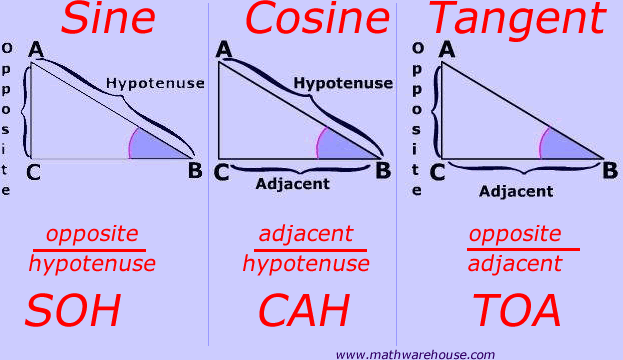
Sections
- Review Of Right Angled Triangles
- The SOH CAH TOA Memory Aid Acronym
- Finding The Angles Given The Ratios
Review Of Right Angled Triangles
A right angled triangle is a triangle with three sides, three corners and three angles. One of the three angles is 90 degrees and the three angles add up to 180 degrees.
The longest side in a right angled triangle is the hypotenuse and is opposite to the right angle (right angle is the largest angle). Also, the shortest side is opposite to the smallest angle and the second largest/smallest angle is opposite to the second longest/shortest side in a right angled triangle.
A Special Case
If the right angled triangle is an isosceles triangle with the angles being 90 degrees, 45 degrees, 45 degrees, the sides opposite to the 45 degree angles are the same.
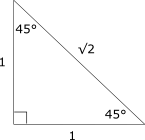
Pythagorean Theorem Review
The Pythagorean Theorem is used for right angle triangles and is used to find the third side length. The key formula is:

where the side lengths a and b are the legs of the triangle. The longest side length c is called the hypotenuse.
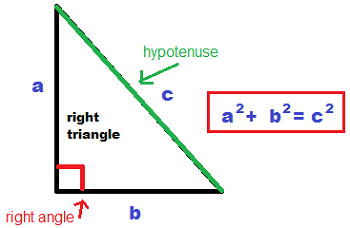
The SOH CAH TOA Memory Aid Acronym
A previous post did mention the use of the Pythagorean Theorem formula for finding the lengths of missing sides. The formula is useful under certain conditions but we need another strategy for cases when there there is one known side and the other two side lengths are unknown.
Given a right angle, a second angle and only one side length, the SOH CAH TOA memory aid is useful for dertermining missing side lengths and angles. The Pythagorean Theorem may be needed along with SOH CAH TOA.
Sine Of An Angle (SOH)
Given an angle theta, the sine of an angle is given by the side length opposite to  (theta) divided by the side length of the hypotenuse.
(theta) divided by the side length of the hypotenuse.

Cosine Of An Angle (CAH)
The cosine of an angle  is given by the side length adjacent (next to) to
is given by the side length adjacent (next to) to  divided by the side length of the hypotenuse. Note that the adjacent side is NOT the hypotenuse of the right angle triangle.
divided by the side length of the hypotenuse. Note that the adjacent side is NOT the hypotenuse of the right angle triangle.

Tangent Of An Angle (TOA)
The tangent of an angle  is the ratio of the opposite side length divided by the side length of the adjacent side to
is the ratio of the opposite side length divided by the side length of the adjacent side to  .
.

The image below provides a summary of the three trigonometric ratios.
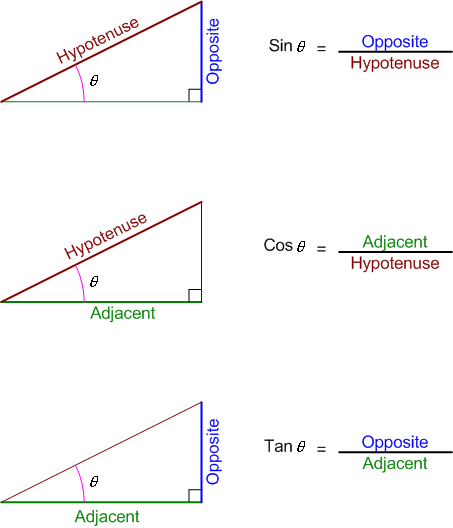
Example
For this example, I am using this image (below):
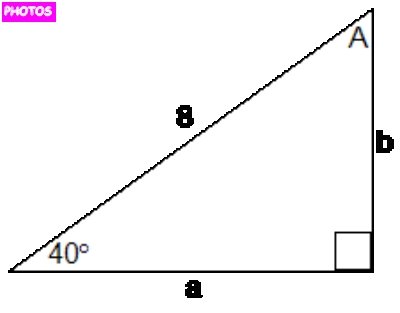
With 40 degrees as the reference angle  , the trigonometric ratios can be evaluated as follows.
, the trigonometric ratios can be evaluated as follows.
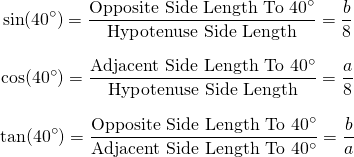
Finding The Angles Given The Ratios
The SOH CAH TOA memory aid can also be used to find missing angles. In the previous section, an angle was given in order to evaluate the trigonometric ratios.
If we have the ratios and not the angle, we use the associated inverse trigonometric function to go from ratios to the reference angle.
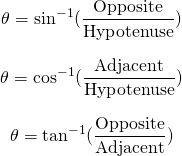
Example
For this example, refer to the image below. Angle A replaces theta here. In a scientific calculator, it is common to use the second function to access the inverse trigonometric functions.

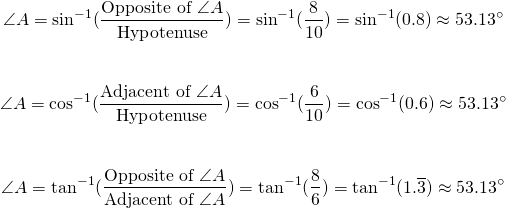
Math text is done in LaTeX with QuickLaTeX.com. Images belong to the respective websites.